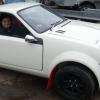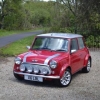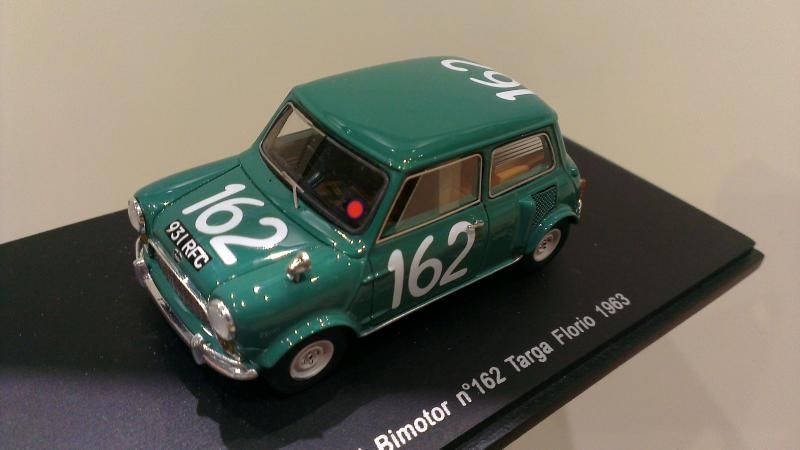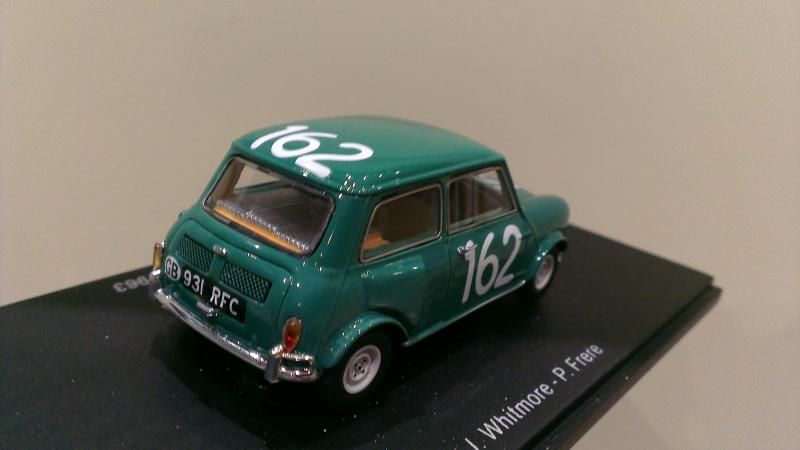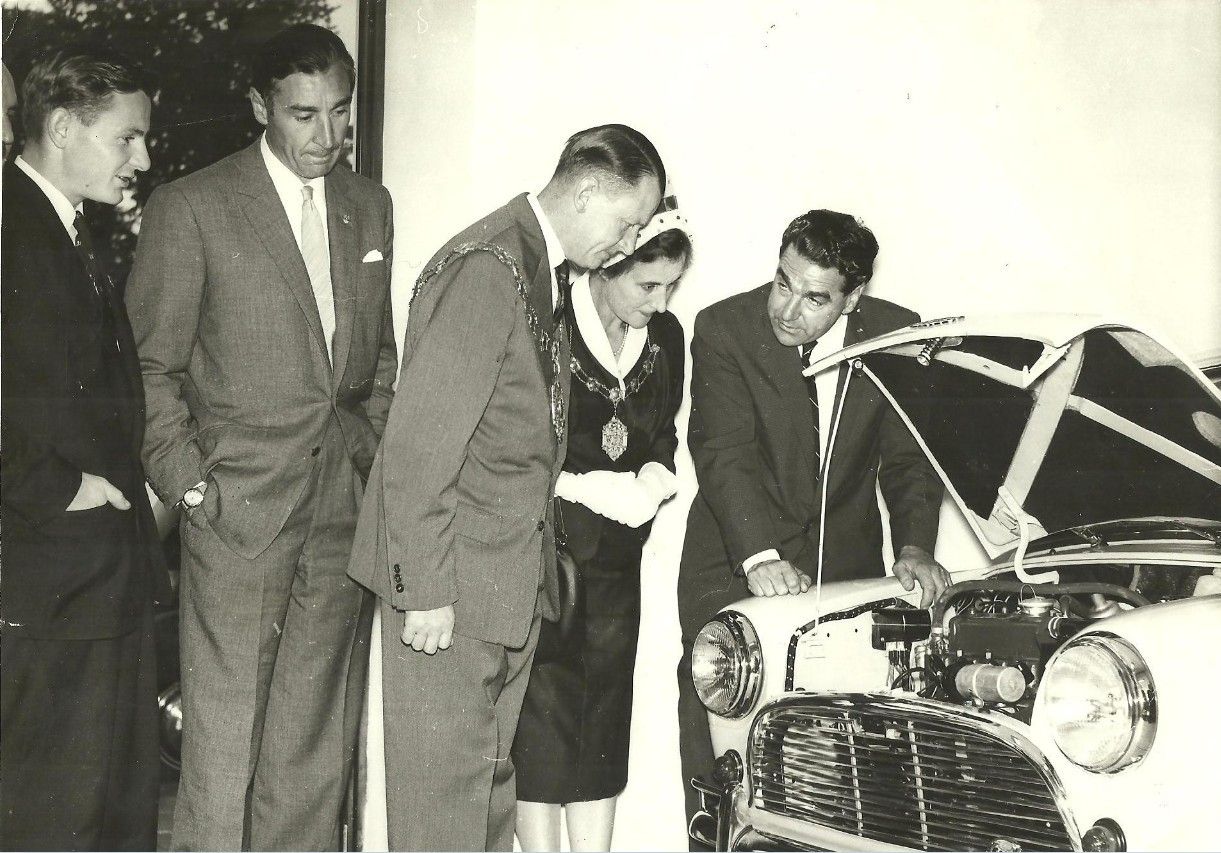Bit of a random request, but does anyone know where he crashed his twini? Somewhere on the Kingston bypass?
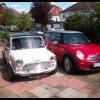
The Cooper Works Later The Traffic Police Garage In Surbiton, Surrey
#16

Posted 02 June 2014 - 10:35 PM
#17

Posted 03 June 2014 - 06:50 PM
Yes, the A3 Kingston-by-pass which runs from New Malden, on past Tolworth Tower towards Hook underpass (and very near John Coopers Garage at Surbiton end of Tolworth Broadway).


"There were two Twini Mini's (and a Moke). One was built by John Cooper, in which John Cooper had his near fatal accident on the Kingston By-Pass. The other was built by Downton engineering and was the car which raced in the Targa Florio. Is main problem was weight which was not much less than a GTO Ferrari against which it had to race, Cooper's accident was the same week as the Targa."
This is an account of Cooper's accident taken from Rob Golding's book ˜Mini“ Thirty Five Years On.
"Failure seemed to dog the tracks of the Twini and enthusiasm was even further dampened when John Cooper had a horrific accident in a road-going Twini. It was the third in a series of accidents in which Cooper was involved and very nearly his last. He was returning from Fairoaks airport having been to collect his Tri-pacer light aircraft. This had crashed some months earlier when he and Lotus chief Colin Chapman were aboard with a professional pilot at the controls. It had cartwheeled on landing without causing injury to anyone. When he collected it, it had sustained further damage while on the ground. The tailplane was badly bent and had he failed to notice it before trying to take off, he could have been in serious trouble again. As it was, he was in a hurry on his way home to collect his wife, Paula, at Surbiton to join Salvadori for dinner.
The Twini was equipped with two 1300cc engines, which were to have been tweaked up to 135 bhp apiece with fuel injection. Batting along the Kingston bypass at 100 mph, the steering arm that had been welded-up to the rear subframe came adrift. As the rack had been removed, the steering link had been used as a suspension arm. The wheel was suddenly free and made a sharp right turn. The car catapulted end-over-end into a wall, throwing Cooper clear but fracturing his skull. Few who saw him thought he would live. The first car on the scene “one that Cooper had just overtaken“ contained a lady who suffered a nervous breakdown as a result of seeing the accident unfold, and she tried unsuccessfully to claim for compensation from Cooper's insurance."
There is quite a bit about the other Twinis in the book. The first one was a Moke that Issigonis built in early 1963. It had a 950cc engine at the front and an 850cc one at the back. John Cooper was shown the car and he and Issigonis both decided they would build a Mini-bodied version. Cooper completed his one day before Issigonis and had it ready for track testing within weeks. John Whitmore did the test driving. By April 1963 both engines were fully-tuned Coopers and the result was a 2.5-litre vehicle developing 175 bhp, and wheelspin on all four wheels.
The pic below is the Twini Mini (931 RFC) on the 1963 Targa Florio, drivers were Sir John Whitmore and Paul Frere. Two separate 998cc engine/gearbox combinations were used....interestingly....when the rear engine failed they just drove it around on the front, hence their poor placing."
You can also see the air vents cut into the bootlid.
Mini Twini: twin-engined, four-wheel-drive concept tested in full
http://www.classican...-tested-in-full
Edited by mab01uk, 03 June 2014 - 06:58 PM.
#18

Posted 03 June 2014 - 07:00 PM
More on the Twini crash on the A3.....
An excerpt from "John Cooper Grand Prix Carpet-Bagger" The Autobiography of John Cooper with John Bentley. John talks about the twin-engine Mini and the crash:
"At the time, I happened to be using a twin-engine Mini destined to cause me a lot of grief. I had driven this car from our Surbiton garage to Fairoaks, left it there while I got a lift up to Luton by plane, where I picked up my Tri-Pacer and flew it back to Fairoaks.
I had no sooner landed than someone told me there was an air display at Biggin Hill in Kent, that day, so a couple of the boys asked if they could cadge a lift and we went on by air to Biggin Hill to watch the aerobatics. When we got ready to fly back, "Sport" Martin, who was with me, remarked, "Have you inspected your plane, John? You're supposed to do that before takeoff, you know:"
"But it's just been repaired," I said.
"Take a look anyway," he insisted. And sure enough the tail of the aircraft was all bent over. Someone obviously had run into it while it was parked but had not even taken the trouble to leave a note. So once again the plane was pushed into the local Piper agent's hangar, that happened to be at Biggin Hill, for still another repair session. I phoned the Fairoaks Flying Club to see if they could send anyone to pick us up. They could and did. They sent a man with a private pilotâs license (which he had only just obtained) to fetch us, and besides getting lost on the way home I just admit this chap frightened us to death! But somehow we made it back to Fairoaks in one piece and I got into my Mini for the delayed drive home.
Talk about jumping from the frying pan into the fire! That night I was having dinner with Roy Salvadori at his house in Esher, along with Bruce McLaren. My wife, Paula, was going to be there, together with the other wives and the whole thing had been planned in advance. But Fate had decreed otherwise. On the way home from Fairoaks to Surbiton (where I planned to stop off and change for dinner), something let go in the Mini while I was on the Kingston Bypass. The car went end over end with almost no warning, and the next thing I knew was that I woke up in hospital without knowing where I was or how I had got there. My first recollection, in fact, was a vague belief that the jockey who had flown us back from Biggin Hill to Fairoaks had become involved in some terrible shunt.
One often wonders if when there is trouble ahead, things tend to build up to the final situation. First, there had been the incident of the bent tail on my damaged plane, which I had nearly flown back without knowing it. Suppose we had taken offâwhat would have happened? We might have run into serious trouble. Then that harrowing return flight to Fairoaks with our lives in the hands of some character who didnât seem to know much. Our landing a bit late and my hurrying off in the Mini to get home and change, although in the ordinary course of events I wasnât one to go very fast along the highways. My racing days were already a decade past.
Then, as I lay there in my hospital bed, things began to sort themselves out. I remembered driving along the Kingston Bypass and being pleasantly aware of the tremendous power of my little car, with two Mini-Cooper engines stuffed into one chassis! I recalled experiencing a sense of great pleasure at the terrific road-holding and neutral steering character of the car. I even got as far as a vague recollection that something had let go at the back, though in that split second I had no idea what it was. Later examination did establish the cause of the accident, which, I think, could fairly be called unusual.
This particular Mini actually had two front subframes, installed back to back so as to accommodate both engines, one up front and the other at the rear. The subframe fitted at the back had, of course, been modified to perform its particular job, although it was basically the same as its front counterpart. We had removed the rack and used the steering links as another suspension arm which pivoted on the subframe. Unfortunately, it was one of those steering links that let go. To get into slightly more detail, it was the ball joint on the end of the link which we had secured to the subframe instead of the rack itself. We had been testing this car some time previously in the snow, because the twin-engine Minis were very good under severe conditions. Following a demonstration to the Press boys, the car had been put aside so that we might install some better engines with a view to racing it. I think that what happened was pretty clear. One of the ball joints had somehow got snow in it, which produced enough rust to make the whole thing sieze up and break off. As a result, a rear wheel suddenly made a sharp right turn there no longer being anything to keep it going straight, and as I was motoring along at probably 100 mph, the result wasn't hard to imagine. A sudden veering to one side, followed by a number of somersaults!
I wasn't strapped in when all this happened. A lot of people later said that if I had been using my seat belt I probably would have killed myself, but I think that the opposite would have been true and I might have escaped serious injury, particularly since the car didnât catch fire. What did the real damage was when I hit my head on the doorpost during one of the rolls.
The place where the accident occurred was a very fast stretch on the Kingston Bypass, and interestingly enough, after all these years, there is still a deep gash along the wall where the car finished up.
At this point it might be appropriate to talk about the origin of this interesting machine. In those days, Alec Issigonis (a brilliant automotive engineer with BMC "the British Motor Corporation" about whom I shall have a lot more to say later) was a great one for thinking up new ideas, and it was he who had discussed with me the notion of putting two engines in to a Mini. The layout was so compact and took up so little room because of the transverse mounting of both units, that it seemed like a natural to try out. By then, Alec had spent a lot of timeâboth of his own and that of BMC developing a machine called the "Moke", which was intended primarily for the Army. It was in fact a Mini-Jeep, so built that the windshield would fold flat and the steering wheel could be collapsed, allowing these vehicles to be stacked into an aircraft or a ship like layers of biscuits, one on top of the other. The very small wheels and general compactness were of course a great asset.
The first twin-engine setup was in fact installed in a Moke, which was also Alec Issigonis' idea. The thinking behind all this was very good, intensely practical and typical of the man. Normally, the most expensive item on a four-wheel-drive vehicle is the transfer box, in addition to which or perhaps because of which handling problems always seem to arise. At least they did in those days. But the idea behind the twin-engine Mini was much simpler. Each power unit operated independently of the other, and fitting a second engine was cheaper and simpler than the complications and cost involved with the usual transfer gear. Admittedly, a small amount of load-carrying capacity had to be sacrificed, but with transverse engines it didnât amount to much. Against this, the actual performance was enormously improved.
There were other considerations too. If the car was on a flat road you could use the front engine alone, or the rear. There was no need to use both. The inactive one simply stayed in neutral. What in fact this amounted to was that you always had a spare engine available for use on difficult terrain such as, for example, the desert. The same was true under conditions of snow and mud. With both engines going, you would then have the finest imaginable vehicle for those conditions. And the cost was less than using a transfer box for four-wheel drive with a conventional layout. I think, despite my accident, that the advantages easily overruled the drawbacks. Our military people, on the other hand, disagreed. They decided they would sooner spend the money on a transfer box than on an extra engine. I think they made a big mistake, and most certainly my accident was in no way related to the basic principles upon which the twin-engine Mini was designed. Until the moment of that shunt, the little car had run beautifully and displayed great potential.
Unfortunately, Issigonis did not have any interest in marketing a twin-engine Mini for sale to the general public. His sole interest was beamed toward the use of this car for military purposes. I don't think he really saw any future in a passenger car so equipped, although for my part, as soon as I got involved with this setup I immediately started to build a regular bodied, twin-engine Mini for my own useâwith the help of Isssigonis, of course. My idea was to produce a thousand of these cars to get the design homologated by the FIA and win saloon (sedan) car races and rallyes. I am still convinced that with more development work strengthening the gearbox among other things this dual-engine Mini would have been a great success and a sure bet to win rallyes and closed circuit races as well. It would have been a natural, for example, at the Nurburgring.
We had started off with two 1000 cc engines, but the car in which I crashed had two 1300 cc power units, which was really going some! These were just stock 1300's, but our intention had been to put in two full-house racing power units! What this would have meant is not hard to imagine when you consider that our later, fuel-injected 1300 cc engines were producing 135 bhp apiece! We could also have used ZF self-locking differentials front and rear, instead of the normal production type. Given 270 bhp in a car weighing about 12 cwt (1,344 pounds), we would have obtained a power-weight ratio of under five pounds per bhp, which at any time and even in straightâout competition cars would mean terrific acceleration and performance."
John goes on to describe how a lady who witnessed his crash experienced a ânervous breakdown and tried to claim compensation from his insurance company. Apparently this wasn't successful. He was in hospital for three weeks and spent two or three weeks recuperating at Littlehampton. It was because he enjoyed the place so much that he moved to the South Coast for good.
The original Cooper Twini at Goodwood 1963 - Photo: John Adams
Edited by mab01uk, 06 May 2015 - 07:15 PM.
#19

Posted 12 August 2014 - 01:17 PM
Ultimate Mini Garage?
Ex-John Cooper Works in Surbiton is for sale/to let:-
http://bonsors.agenc...=7&agkey=296 97
Edited by mab01uk, 12 August 2014 - 01:19 PM.
#20

Posted 25 November 2014 - 08:29 PM
Put me out of my misery someone please; in the little film of John Cooper driving his single seater down the Kingston by-pass as he passes the bus there is a finned tower in art-deco style in the middle distance - what did it signify? I was born in Kingston in 1955 and lived on the by-pass (later A3) over 40 years watching it develop into the ghastly thing it is now. The presence of the 152 bus and the fact that the road is raised about 3 to 4 feet puts this stretch as being that between the Toby Jug (long demolished) at Tolworth and the "Ace of Spades" (there`s life there Jim but not as I knew it). I would also hazard that it`s just about where Gala cosmetics used to was on the south side, I worked for them of an evening to make my apprentice`s wage go a bit further. I`m sure Gala has long gone too but I don`t know who owns the building/site these days. Great to see something from my very earliest days before we all died a lingering death.
#21

Posted 26 November 2014 - 05:09 PM
A career in beauty 60s #Surbiton style! Gala Cosmetics was run by Stanley Picker & stood on #Kingston by-pass 1945-83
https://twitter.com/...373909145776129
I drive down that stretch of the A3 each day and Gala is long gone (1945-83) and the site is now occupied by modern industrial buildings and offices I think.
Do you mean the tower with the black diamond shape on it?
If you look at the old Gala job advert the building and tower can be seen with the black diamond shape on it which I think was the Gala Cosmetics sign / logo visible from the A3?
Edited by mab01uk, 26 November 2014 - 05:18 PM.
#22

Posted 26 November 2014 - 07:40 PM
By George I think you`ve got it! lol. Yes that`s the one and it would just about pin-point Gala. Also when the camera looks t`other way you can see a short row of shops with flats over (still there). My brother in-law lived in one for a while and I bought some headlights for my Mini Cooper there when I lived virtually at the top of Gala`s road. Aaaah, happy days..........
#24

Posted 27 November 2014 - 11:55 PM
Good on ya mate, didn`t even know such a model existed!
#25

Posted 22 January 2015 - 06:59 PM
Video tour of the Metropolitan Police's 'V' Division Traffic Garage, formerly the Cooper Works in Surbiton, Surrey until the 1970's.
Charles Cooper moved into 243 Ewell Road Surbiton in 1934. This was a corner shop at the Junction with Hollyfield Road, to the rear was the site that would become Cooper Cars
At that time it was a corrugated building, with a small stream 'out back'. It is rumoured that Charles kept ducks on the stream. The Cooper family would for awhile live in the flat above the corner shop. The site was first known as Cooper's Garage and it operated a 24hr breakdown service. Later it would also possess a Vauxhall dealership and later still the Metropolitan Police Garage TDV.
Edited by mab01uk, 22 January 2015 - 07:13 PM.
#26

Posted 03 February 2015 - 08:33 AM
I was HQ'q (back in about '82 - 83) at the top of the Ewell Road , near what was then Currie Motors Ford agents. I used to drive past the cooper site every day and if my memory serves me right, the corner showroom was a second hand Mini dealer in the '80's? I seem to remember that they were in business for some years.
And of course there was the Mini specialist, down on Upper Brighton Road with the back end of a Mini hanging off the wall. But I digress......
Edited by B7TMW, 03 February 2015 - 08:34 AM.
#27

Posted 03 February 2015 - 02:02 PM
Indeed you are right, there was a used Mini dealership there with a few examples on the main road too. The place further up the road with the back end of a Mini on the wall with "HELLLP" on the number plate was where I bought my 1275 GT, a lovely little motor that I did the London - Brighton in once or twice.
#28

Posted 03 February 2015 - 07:19 PM
Indeed you are right, there was a used Mini dealership there with a few examples on the main road too. The place further up the road with the back end of a Mini on the wall with "HELLLP" on the number plate was where I bought my 1275 GT, a lovely little motor that I did the London - Brighton in once or twice.
I think the ex-Cooper corner showroom was called the 'Surbiton Mini Centre" in the 1980's.
The other local Mini landmark in Surbiton, Surrey below.....

#30

Posted 11 February 2015 - 04:55 PM
Indeed you are right, there was a used Mini dealership there with a few examples on the main road too. The place further up the road with the back end of a Mini on the wall with "HELLLP" on the number plate was where I bought my 1275 GT, a lovely little motor that I did the London - Brighton in once or twice.
I think the ex-Cooper corner showroom was called the 'Surbiton Mini Centre" in the 1980's.
The other local Mini landmark in Surbiton, Surrey below.....
Quite right Mab, it was indeed the Surbiton Mini centre both for the ex Cooper premises and the showroom on the Ewell Road.
1 user(s) are reading this topic
0 members, 1 guests, 0 anonymous users





